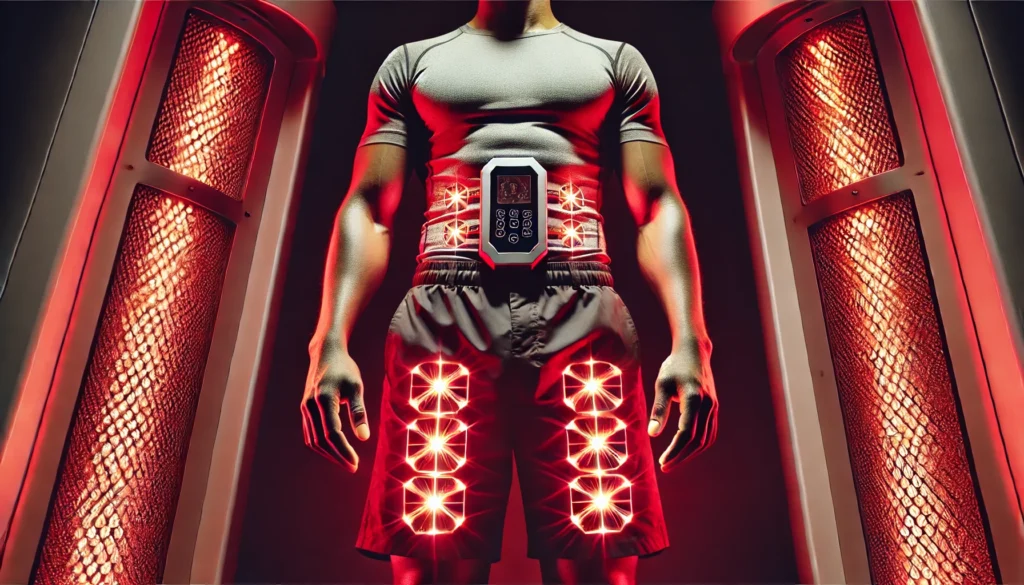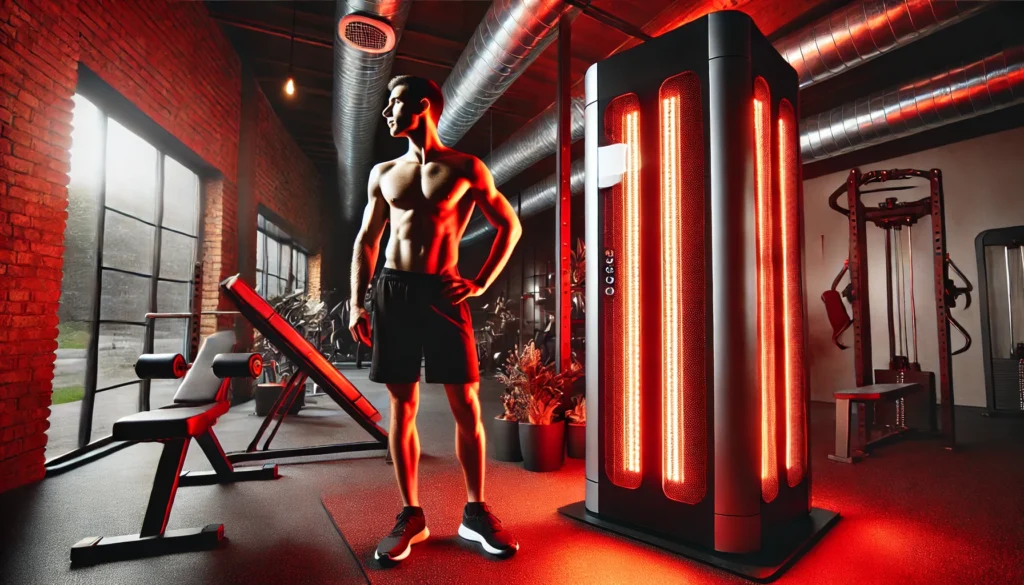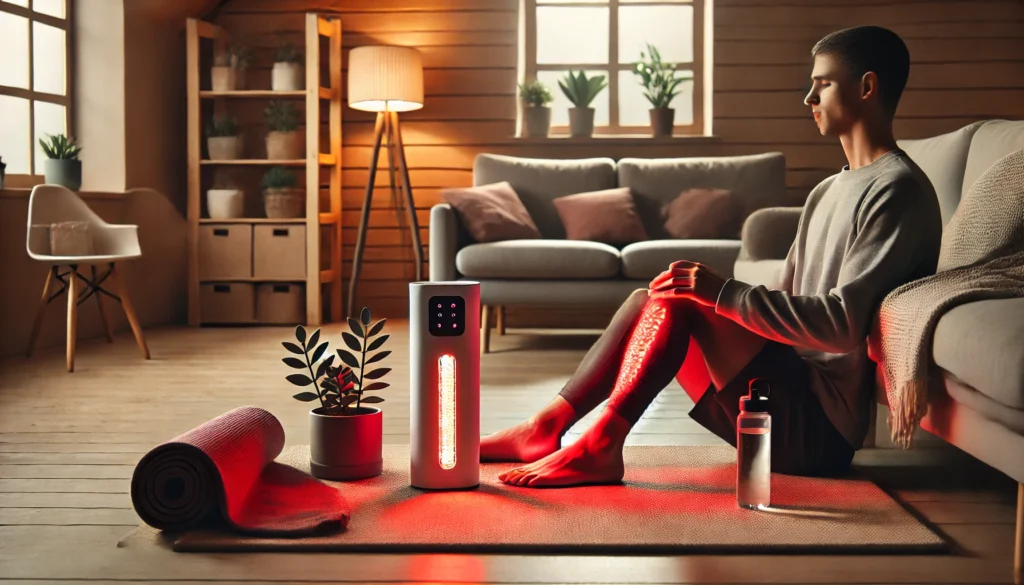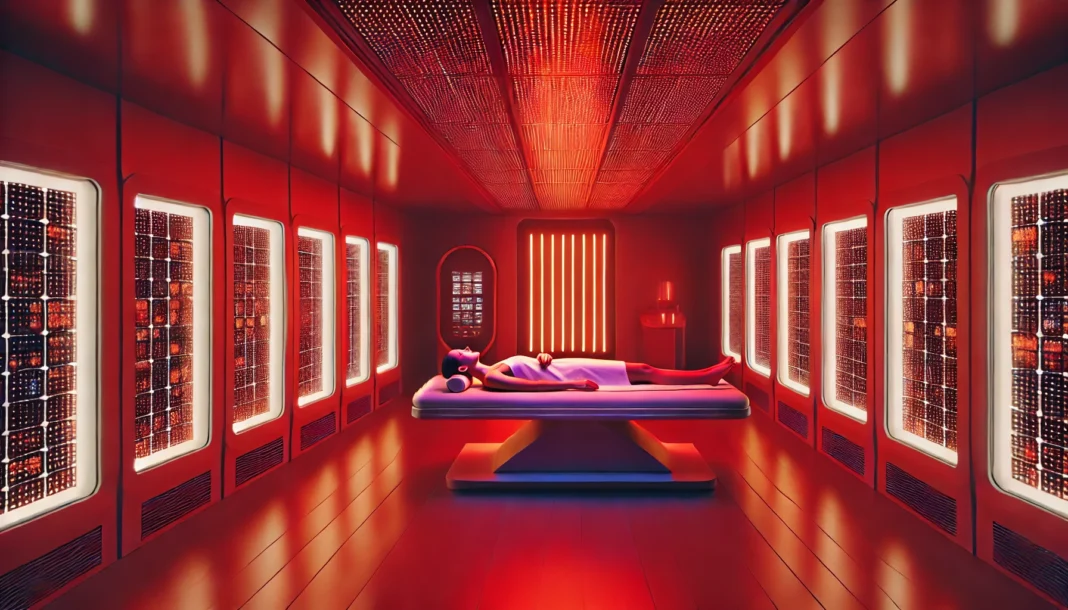Understanding Red Light Therapy and Its Mechanisms
Red light therapy, also known as low-level laser therapy (LLLT) or photobiomodulation, has gained significant attention in recent years for its potential to enhance weight loss, facilitate fat reduction, and support athletic recovery. Originally used in medical and therapeutic applications for wound healing and pain management, red light therapy has now expanded into the fitness and wellness industries. The therapy works by utilizing specific wavelengths of red and near-infrared light to penetrate the skin, stimulating cellular activity and improving mitochondrial function.
You may also like: Red Light Therapy for Muscle Recovery: How Athletes Can Speed Healing and Enhance Performance
Scientific research has shown that red light therapy has a profound impact on cellular energy production, primarily through its interaction with mitochondria. By increasing adenosine triphosphate (ATP) synthesis, the fundamental energy currency of cells, red light therapy enhances metabolism and promotes fat oxidation. This process has made it a promising tool for individuals looking to optimize their weight loss journey. Additionally, its ability to reduce inflammation, improve circulation, and support muscle recovery further solidifies its role in athletic performance enhancement.
Red Light Therapy for Fat Loss and Metabolism Enhancement
One of the most compelling aspects of red light therapy is its potential to accelerate fat loss. Unlike traditional fat loss methods that rely on caloric restriction or high-intensity exercise, red light therapy offers a non-invasive and passive approach to body contouring. Research suggests that exposure to red and near-infrared light can influence adipocytes (fat cells) by triggering the release of stored lipids. This process, known as lipolysis, allows the body to use fat as a source of energy, thereby reducing overall body fat percentage.
The effects of red light therapy on fat metabolism are supported by studies demonstrating its ability to alter the permeability of fat cell membranes. As light energy penetrates the skin, it creates small, temporary pores in fat cells, allowing triglycerides to be released. This makes fat more accessible for metabolic processes, particularly during exercise. Individuals who incorporate red light therapy into their fitness regimen may experience greater fat loss efficiency, as their bodies become more adept at utilizing stored energy.
Furthermore, red light therapy enhances blood circulation, which plays a critical role in nutrient delivery and metabolic waste removal. Improved circulation ensures that oxygen and nutrients reach tissues efficiently, optimizing the body’s ability to burn fat and maintain a lean physique. The combined effects of increased ATP production, enhanced lipolysis, and improved circulation contribute to the growing interest in red light therapy as a viable tool for weight management.
Red Light Therapy on Stomach: Targeting Abdominal Fat
Many individuals seeking weight loss are particularly concerned with reducing abdominal fat, which is often the most stubborn area to target. Red light therapy on the stomach has become increasingly popular due to its ability to promote localized fat reduction. While spot reduction has long been considered a myth in traditional fitness methodologies, emerging evidence suggests that red light therapy may offer a way to specifically target problem areas.
Studies have found that red and near-infrared light can penetrate the deeper layers of the skin, directly affecting fat cells in targeted regions. When applied to the stomach, red light therapy stimulates lipolysis in the abdominal area, helping to shrink fat cells and contour the midsection. This makes it an appealing option for individuals looking to refine their body composition without resorting to invasive procedures such as liposuction.
Moreover, the therapy’s ability to reduce inflammation is particularly beneficial for abdominal fat loss. Chronic inflammation has been linked to increased visceral fat storage, which poses significant health risks such as metabolic syndrome and cardiovascular disease. By mitigating inflammation and enhancing cellular function, red light therapy supports a healthier fat distribution and promotes overall wellness.
Contour Light Therapy: A Non-Invasive Approach to Body Sculpting
Contour light therapy, a specialized form of red light body contouring, has emerged as a sought-after treatment in aesthetic and wellness clinics. Utilizing high-powered LED panels or laser diodes, contour light therapy delivers concentrated wavelengths of red and near-infrared light to specific areas of the body. The goal is to accelerate fat loss while simultaneously tightening and toning the skin.
Unlike traditional weight loss methods that rely on caloric deficits or invasive surgical procedures, contour light therapy provides a gentle yet effective approach to reshaping the body. This treatment is particularly beneficial for individuals who have reached a plateau in their weight loss journey or struggle with localized fat deposits that are resistant to diet and exercise. Sessions are typically painless, with individuals experiencing a warming sensation as the light penetrates their skin and stimulates fat metabolism.
Another advantage of contour light therapy is its ability to enhance skin elasticity and collagen production. As fat cells release stored triglycerides, the skin in treated areas tightens, reducing the appearance of sagging or loose skin. This dual effect of fat reduction and skin rejuvenation makes contour light therapy an attractive option for those seeking comprehensive body transformation.

Enhancing Athletic Recovery and Performance with Red Light Therapy
Beyond its applications for weight loss and fat reduction, red light therapy is widely recognized for its benefits in athletic recovery and performance optimization. Athletes and fitness enthusiasts often experience muscle fatigue, microtears, and delayed onset muscle soreness (DOMS) after intense training sessions. Red light therapy has been shown to accelerate the healing process, allowing individuals to recover faster and perform at their peak.
One of the primary ways red light therapy supports recovery is by reducing inflammation and oxidative stress. Exercise-induced muscle damage often results in an inflammatory response, leading to soreness and prolonged recovery times. By stimulating cellular repair mechanisms and increasing circulation, red light therapy mitigates these effects, promoting faster muscle regeneration. Additionally, its ability to enhance ATP production provides muscles with the energy needed for efficient repair and growth.
Research has also highlighted the role of red light therapy in reducing joint pain and improving flexibility. Athletes who incorporate red light therapy into their recovery routine report decreased stiffness, improved range of motion, and enhanced overall performance. Whether used before a workout to warm up muscles or post-exercise to aid in recovery, red light therapy serves as a valuable tool for maintaining peak physical condition.
Does Red Light Therapy Work for Weight Loss? Examining the Evidence
Skepticism often arises when discussing non-traditional weight loss methods, prompting the question: does red light therapy work for weight loss? The answer lies in the growing body of research supporting its efficacy. Multiple clinical studies have demonstrated that individuals who undergo red light therapy experience measurable reductions in body fat, particularly when combined with a healthy lifestyle.
A study published in the journal Lasers in Surgery and Medicine found that participants who received red light therapy treatments showed significant reductions in waist circumference and overall body fat percentage compared to those who did not receive treatment. Another study indicated that red light therapy users experienced improved insulin sensitivity, suggesting a positive impact on metabolic health.
While red light therapy alone is unlikely to produce dramatic weight loss results without lifestyle modifications, it serves as an effective adjunct to traditional methods. When paired with regular exercise and a balanced diet, red light therapy enhances fat metabolism, supports muscle recovery, and accelerates overall weight loss progress.
Frequently Asked Questions About Red Light Therapy for Weight Loss and Athletic Recovery
1. How does red light therapy compare to other weight loss methods? Red light therapy for weight loss offers a unique approach compared to traditional methods like dieting and exercise. Unlike calorie-restrictive plans or high-intensity workouts, red light contouring stimulates fat cells to release their stored energy, making it easier for the body to metabolize fat. This process does not induce stress on the body, unlike extreme dieting, which can lead to metabolic slowdown, or intense exercise, which may cause muscle strain. Additionally, contour light therapy enhances circulation, ensuring that oxygen and nutrients efficiently reach cells, further supporting fat loss. This method is particularly beneficial for individuals who struggle with stubborn fat deposits that do not respond well to conventional weight loss strategies.
2. Can red light therapy help you lose weight without exercise? While red light therapy can aid in fat loss, combining it with a healthy lifestyle yields the best results. Red light therapy on stomach areas, for example, can help mobilize fat, but physical activity enhances its utilization as energy. Those using red light therapy weight loss at home should incorporate light exercise, such as walking or strength training, to maximize fat-burning potential. In addition to supporting fat metabolism, red light therapy also promotes skin tightening, helping to reduce the appearance of sagging skin that can occur with weight loss. Thus, while red light therapy can contribute to fat reduction, integrating movement and balanced nutrition amplifies its effects.
3. Does red light therapy help with muscle recovery and athletic performance? Yes, red light therapy is widely recognized for its ability to enhance athletic recovery and performance. By stimulating mitochondrial activity, it accelerates cellular repair, reducing muscle soreness and inflammation. Many athletes use red light therapy to lose weight while preserving lean muscle mass, as it helps prevent muscle degradation. Additionally, infrared weight loss treatments improve blood flow to the muscles, delivering oxygen and nutrients that promote faster healing. Athletes incorporating body contouring red light therapy into their regimen often report improved endurance and reduced recovery times between workouts.

4. What are the red light therapy benefits for weight loss beyond fat reduction? Beyond its impact on fat loss, red light therapy provides numerous additional benefits that contribute to a healthier body composition. One major advantage is its ability to enhance collagen production, improving skin elasticity and reducing cellulite appearance. Red light therapy on stomach areas not only aids in fat reduction but also minimizes stretch marks and skin sagging. Additionally, red light body contouring supports lymphatic drainage, helping the body eliminate toxins more efficiently. This process can improve digestion, boost energy levels, and support overall metabolic health.
5. How much weight can you lose with red light therapy, and how quickly? Results from red light therapy for weight loss vary depending on individual factors such as metabolism, lifestyle, and frequency of treatments. Some studies and red light therapy for weight loss reviews indicate that individuals can lose inches off their waist within a few weeks of consistent use. While dramatic weight loss solely from red light body contouring is unlikely, combining treatments with a healthy diet and exercise can accelerate results. Those who use red light therapy to lose weight consistently often report noticeable changes in body composition over a period of one to three months. The effectiveness of red light therapy depends largely on an individual’s commitment to complementary healthy habits.
6. Is there scientific evidence supporting red light therapy for fat loss? Yes, numerous studies have explored the effectiveness of red light therapy for fat loss. Research suggests that red and near-infrared light wavelengths penetrate fat cells, prompting the release of stored triglycerides. Studies on contour light red light therapy show reductions in body circumference after multiple treatment sessions. Additionally, red light body contouring reviews frequently highlight improved metabolic markers, such as insulin sensitivity and lipid profiles. Although red light therapy should not replace a healthy lifestyle, scientific evidence supports its role as a supplemental tool for fat reduction.
7. What makes red light therapy on stomach areas particularly effective? The stomach is one of the most common areas where individuals struggle with stubborn fat deposits. Red light therapy on stomach regions is effective because the area typically has a higher concentration of visceral fat, which is metabolically active. Contour light therapy works by increasing circulation and enhancing cellular activity in the treated area, leading to improved fat mobilization. Additionally, red light therapy helps reduce bloating and supports digestion by stimulating lymphatic flow. This makes it a great option for individuals looking to not only slim down but also improve gut health and overall well-being.
8. Can red light therapy be used alongside other fat loss treatments? Yes, red light therapy can complement other fat loss treatments for enhanced results. Many individuals combine red light therapy for weight loss with treatments like cryotherapy, massage, or infrared weight loss therapies to maximize fat reduction. Red light therapy for weight loss reviews suggest that combining modalities enhances circulation, promotes detoxification, and supports long-term fat loss. Additionally, body contouring red light therapy can be used post-liposuction or non-invasive body sculpting treatments to improve skin tightening and healing. By integrating multiple therapies, individuals can achieve a more sculpted and toned appearance.
9. Are there any side effects or risks associated with red light therapy for weight loss? Red light therapy is considered a safe, non-invasive treatment with minimal risks. Unlike surgical procedures or aggressive fat loss treatments, red light body contouring does not cause pain, scarring, or downtime. However, some individuals may experience mild skin sensitivity or temporary redness after prolonged exposure. Those with photosensitivity or medical conditions should consult a healthcare provider before undergoing red light therapy. Ensuring proper usage and following recommended guidelines can help individuals experience the full benefits without adverse effects.
10. What should you look for when choosing a red light therapy device for at-home use? When selecting a red light therapy weight loss at home device, it’s important to consider factors such as wavelength, power output, and treatment area coverage. Devices designed for body contouring red light therapy should emit wavelengths between 630-850 nm, as these are the most effective for fat reduction and cellular regeneration. High-powered LED panels or laser-based devices offer deeper penetration, making them more effective than lower-intensity models. Reading red light body contouring reviews can provide insights into product quality and user satisfaction. Additionally, choosing a device with adjustable settings allows for customized treatments tailored to individual needs.
This FAQ provides additional perspectives and practical insights that enhance understanding of red light therapy for weight loss and athletic recovery while ensuring natural keyword integration.

Final Thoughts: Integrating Red Light Therapy into a Weight Loss and Recovery Plan
Red light therapy presents a compelling option for individuals seeking to optimize weight loss, enhance fat reduction, and support athletic recovery. Its ability to stimulate cellular energy production, promote lipolysis, and reduce inflammation makes it a valuable tool in both aesthetic and performance-based applications. Whether used for targeted fat reduction, body contouring, or post-exercise recovery, red light therapy offers a non-invasive, science-backed solution for achieving fitness and wellness goals.
As the popularity of red light therapy continues to grow, individuals interested in exploring its benefits should consult with healthcare professionals or certified practitioners to determine the most effective treatment approach. By integrating red light therapy into a holistic weight management and fitness strategy, individuals can experience enhanced results, improved recovery, and long-term health benefits.
red light therapy, red light therapy for weight loss, red light contouring, contour light therapy, red light therapy fat loss, red light therapy on stomach, red light body contouring, infrared weight loss, red light therapy benefits, body contouring red light therapy, red light therapy to lose weight, does red light therapy help you lose weight, can red light therapy help you lose weight, red light therapy weight loss at home, red light therapy for weight loss reviews, light therapy for weight loss, contour red light therapy, how much weight can you lose with red light therapy, red light body contouring reviews, contour light red light therapy.
Further Reading:
How Red Light Therapy May Help Weight Loss
What Is Red Light Therapy, and Does It Work for Weight Loss?
Red Light Therapy for Weight Loss
Disclaimer
The information contained in this article is provided for general informational purposes only and is not intended to serve as medical, legal, or professional advice. While NewsHealthWatch strives to present accurate, up-to-date, and reliable content, no warranty or guarantee, expressed or implied, is made regarding the completeness, accuracy, or adequacy of the information provided. Readers are strongly advised to seek the guidance of a qualified healthcare provider or other relevant professionals before acting on any information contained in this article. NewsHealthWatch, its authors, editors, and contributors expressly disclaim any liability for any damages, losses, or consequences arising directly or indirectly from the use, interpretation, or reliance on any information presented herein. The views and opinions expressed in this article are those of the author(s) and do not necessarily reflect the official policies or positions of NewsHealthWatch.

